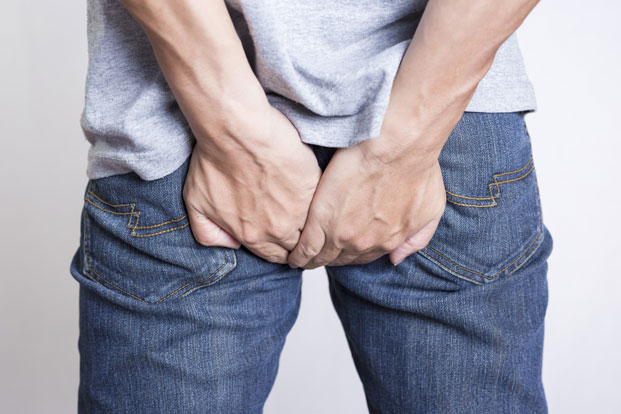A small tear in the tissue that lines the anus is called an anal fissure. This thin tissue most commonly ruptures from the pressure of large stools passing through during a bowel movement and leads to bleeding and pain with subsequent bowel movements.
Fissures are a common condition, comprising roughly 5 percent to 15 percent of a colorectal surgeon’s practice. Men and women are equally affected. Usually the cause is a diet lacking in fiber and fluids, which leads to constipation. A lack of fruit, vegetables, whole grains and nuts in the diet can cause constipation, as can an overload of dairy products like cheese, milk and other calcium-rich foods.
Tears occur in the anoderm, which is a tissue that lines the anal canal and anus, The anoderm has no hair follicles, sweat glands or oily glands (termed sebaceous) and is a very sensitive area with lots of nerves. The anoderm runs the length of the anal canal until reaching the dentate line of the rectum.
People of any age can experience fissures, but they are most common in infants. While most fissures will be cured without any treatment within a couple of months, surgical intervention is sometimes needed to relieve discomfort.
Anal fissures typically are caused by passing hard or large stools; straining during bowel movements; diarrhea that won’t go away; an inflammation caused by Crohn’s disease or other inflammatory bowel movements; and pregnant women who strain during childbirth. In some cases, the fissure can be a sign of anal cancer, tuberculosis, syphilis, herpes, or HIV. In rare cases, insertion of a rectal thermometer, endoscope, ultrasound probe or enema tip can cause a fissure.
Symptoms of an anal fissure include pain during bowel movements that sometimes lasts for hours after the act; bright red blood on toilet paper or visible on the stool; an irritation around the anus, sometimes with itching; a crack in the skin around the anus; or a small skin tag or lump near the fissure.
Many infants will develop an anal fissure during the first year of life, while older adults will get them because of poor circulation or a diet lacking fiber. Decreased blood flow in the area is a common problem that causes problems with elimination.
Some anal fissures that don’t heal are considered chronic and need to be treated with surgery. Having one anal fissure increases the risk of having others. Complications can include tears in the ring of muscle called the internal anal sphincter, making it difficult for the fissure to heal and causing extreme pain that requires surgical intervention.
Diagnosis and Treatment
Doctors will undertake a complete physical exam to understand the condition, with a special focus on diet and lifestyle. Typically, patients are encouraged to drink more water, added fiber to the diet and begin exercising regularly. Laxatives sometimes will be recommended in cases of extreme constipation.
Fortunately, most anal fissures are relatively easy to diagnose. The tear is usually visible during the examination, usually by means of an anoscope, a short, lighted tube that will illuminate the area in the anal canal where the fissure is believed to be located. The location of the fissure is important — a fissure on the side of the anal opening may be a sign of another issue, such as Crohn’s disease or other irritable bowel syndrome condition.
If an underlying condition is suspected, additional testing is usually recommended. These can include a flexible sigmoidoscopy, which examines the bottom portion of the colon with a tiny video camera and light; and a colonoscopy, wherein a flexible tube is used to inspect the entire colon. This is done to detect colon cancer and signs of other conditions in the presence of abdominal pain or extreme diarrhea.
Non-surgical treatment is usually the first recommendation, and doctors may treat anal fissures on an outpatient basis. Externally applied nitroglycerin is used to promote healing and increase blood flow in the fissure area, but there are side effects of the treatment, including headaches. Doctors may also use steroid creams to promote healing or Botulinum toxin type A (commercially known as Botox) to relax spasms in the anal muscle. Some blood pressure medications are also used to relax the area, while sitz baths, which are chemically treated soaks, are also used. In some cases, calcium channel blocking drugs are used to decrease constipation.
If those approaches don’t yield results in a reasonable amount of time or if symptoms continue to increase in severity, surgery is the next step. This usually involves a small incision in the anal sphincter muscle, with the goals of reducing spasms and pain and promoting healing. There is a danger of incontinence from cutting this muscle, but the risk is outweighed by the pain relief.
Post-Surgery Fissure Care
After surgery – or whatever treatment is recommended — it is up to the patient to make changes that will avoid constipation issues in the future, particularly in the weeks following surgery. This means adding roughly 30 grams of fiber to the diet to keep stools soft. Fruits, nuts, vegetables and whole grains are excellent sources of fiber, and a fiber supplement may be added to that in the early stages of healing.
In addition to fiber, staying hydrated by drinking lots of fluids, avoiding strained bowel movements and particularly increasing blood flow by adding exercise are typical post-surgical recommendations. It is also wise to mention your previous condition to specialists before any examinations in the area.
These are habits that have to be maintained for life because the area of the initial anal fissure is now more susceptible to tears, and a lapse into an old lifestyle will put a patient at risk for future issues.

Leave a Reply